Blog categories
Blog archive
RSS Blog posts of '2020' 'November'
Blog Filters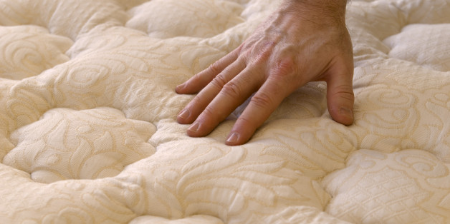
Perfect Mattress: 3 Key Tips to Buy The Ideal Mattress
Friday, November 20, 2020
All of us desire a good night's sleep. Here's where choosing the right mattress can help ensure a serene slumber all night long. When you're getting a new bed, it's crucial to invest in a high quality mattress. As we spend a third of lives sleeping, a suitable mattress will help you sleep better and thus improve your physical, mental and emotional well-being. Here are some tips to arm yourself with when you go shopping for a new mattress. 1 Test for comfort and support Make sure that the surface is both comfortable and supportive of your spine and posture. This means your spine should be in its natural curvature while you lie down flat on the bed. Have someone put his or her hand behind the small of your back. If the person's hand can move easily in the back without any gaps, the mattress is suitable for your posture. If there is a gap in between, the mattress is too hard and not supporting your back properly. If the person cannot get his or hand under your back, the mattress is too soft which causes your back to round up. Also lie on your side and stomach and examine if it's comfortable for you. Always take your time when shopping for a new mattress. 2 Find a mattress that suits your sleep style
How do you sleep? Some of us like sleeping on the back, some can only fall asleep when they are turned to one side and there are others who sleep soundly on their stomach. Your sleeping style is an essential factor when choosing the right kind of mattress.
2 Find a mattress that suits your sleep style
How do you sleep? Some of us like sleeping on the back, some can only fall asleep when they are turned to one side and there are others who sleep soundly on their stomach. Your sleeping style is an essential factor when choosing the right kind of mattress.
 For side sleepers: Get a soft or plush sleeping surface. With extra cushioning, you can prevent pressure-induced discomfort in your shoulders and hips. Plush mattresses offer extra comfort and plush support without the need for additional pillowtop padding.
For back sleepers: Opt for firm or extra firm mattresses as these help to support your back. Firm mattresses generally have a flatter top with no additional padding. Some of them also come with a firm edge support.
For stomach sleepers: Go for a slightly firmer surface so that your spine is properly aligned.
For those who with a combination of sleep styles: You may want to select something that is neither too firm nor too soft so it gives you the flexibility to support your different positions.
3 Consider your sleeping partner
Movements and motion transfers are something to consider if you share your bed with another person. You definitely don't want a mattress that bounces and shakes each time your partner roll to the side or gets up from the bed. Memory foam mattress can help to isolate movements to one side of the bed. You can also go for a hybrid of springs and foam as they usually come with transitional foam that alleviates motion.
For side sleepers: Get a soft or plush sleeping surface. With extra cushioning, you can prevent pressure-induced discomfort in your shoulders and hips. Plush mattresses offer extra comfort and plush support without the need for additional pillowtop padding.
For back sleepers: Opt for firm or extra firm mattresses as these help to support your back. Firm mattresses generally have a flatter top with no additional padding. Some of them also come with a firm edge support.
For stomach sleepers: Go for a slightly firmer surface so that your spine is properly aligned.
For those who with a combination of sleep styles: You may want to select something that is neither too firm nor too soft so it gives you the flexibility to support your different positions.
3 Consider your sleeping partner
Movements and motion transfers are something to consider if you share your bed with another person. You definitely don't want a mattress that bounces and shakes each time your partner roll to the side or gets up from the bed. Memory foam mattress can help to isolate movements to one side of the bed. You can also go for a hybrid of springs and foam as they usually come with transitional foam that alleviates motion.
 Check out our Top 5 Mattress Brands in 2018 post for more ideas.
Check out our Top 5 Mattress Brands in 2018 post for more ideas.

4 Easy and Affordable Ways to Increase Your Property Value
Friday, November 20, 2020
In Malaysia, the local property market is one of the many industries which many Malaysians venture into as a source of investment. Over time, as the value of properties increase, many investors are on the look-out for opportunities with sellers – both independent and developers – on high alert to hopefully pocket some profit. Before sellers capitalise on this opportunity, it is always important for them to understand a property’s market value and how to find ways to increase its worth. The term ‘market value’ defines the price point a typical property would fetch under normal situations. This value is usually determined based on four aspects: external characteristics; internal features; market outlook (supply and demand); and location. As such, sellers who wish to increase the market value of their properties ought to plan ahead before they contemplate listing or engaging an agent. AkzoNobel, the leading global paints and coatings company and producer of decorative paint Dulux, shares a few affordable and easy ways to increase the market value of one’s property: 1 Light up the front lawn When walking through the streets of one’s neighbourhood, more often than not the external appeal of a property would be the first to catch one’s attention. An exterior that is warm, welcoming and structurally-sound forms a good first impression, so sellers take note: snap a digital photo of your property and look at it in black and white. When all colours are removed, you can better see the cracks in the walls and the glaring flaws.
Now, the first step to exterior beautification is to make a list of simple renovation ideas such as decorating the walkway with flower pots or LED lights. Make the main door more visually-appealing with a catchy colour, so consult a professional for more ideas, or simply find interesting ideas online for reference. Repainting is one of the simplest and most affordable ways to charm passers-by.
2 Upgrade your kitchen
When walking through the streets of one’s neighbourhood, more often than not the external appeal of a property would be the first to catch one’s attention. An exterior that is warm, welcoming and structurally-sound forms a good first impression, so sellers take note: snap a digital photo of your property and look at it in black and white. When all colours are removed, you can better see the cracks in the walls and the glaring flaws.
Now, the first step to exterior beautification is to make a list of simple renovation ideas such as decorating the walkway with flower pots or LED lights. Make the main door more visually-appealing with a catchy colour, so consult a professional for more ideas, or simply find interesting ideas online for reference. Repainting is one of the simplest and most affordable ways to charm passers-by.
2 Upgrade your kitchen
 It may sound unbelievable at first, but many real estate experts have reported that the kitchen is the number one must-upgrade item for greatest returns. According the latest Cost vs Value report from Remodelling magazine, the national data shows that a minor kitchen project may yield up to 81% returns on investment. That means for every RM100 spent on the upgrade, the home value increases by RM83 on average, which sounds like a fair deal.
Here are a few tips for minor kitchen remodelling:
- Change the paint. It’s simple, but it works.
Keep the interior and colour scheme simple. Think neutral for wall colours, and by that we don’t mean white. Go natural and subdued. Dulux’s Colour of the Year 2018, Heart Wood, is a nice pinkish brown which adds sophistication and subtle elegance to one’s kitchen. Pair with surfaces and fixtures that are versatile, not busy or too loud. Remember, simplicity is the key.
- Embrace stainless steel.
Not all professional grade-models home appliances work for everyone. The key to remodelling is to appeal to the masses, so try to incorporate high quality stainless steel materials into the kitchen instead. The cold feel of steel is a hotcake for many buyers, and it will give a better return.
- Add in a “Wow” factor
Spruce things up a little to add that extra mile to one’s home. Consider hanging a pot rack with fresh greeneries, pans and a suspended wine bottle holder to create a modern look. Lighting, such as under-cabinet fixtures, will also add ambiance and show off the materials in the kitchen.
3 Beautify your bathroom
It may sound unbelievable at first, but many real estate experts have reported that the kitchen is the number one must-upgrade item for greatest returns. According the latest Cost vs Value report from Remodelling magazine, the national data shows that a minor kitchen project may yield up to 81% returns on investment. That means for every RM100 spent on the upgrade, the home value increases by RM83 on average, which sounds like a fair deal.
Here are a few tips for minor kitchen remodelling:
- Change the paint. It’s simple, but it works.
Keep the interior and colour scheme simple. Think neutral for wall colours, and by that we don’t mean white. Go natural and subdued. Dulux’s Colour of the Year 2018, Heart Wood, is a nice pinkish brown which adds sophistication and subtle elegance to one’s kitchen. Pair with surfaces and fixtures that are versatile, not busy or too loud. Remember, simplicity is the key.
- Embrace stainless steel.
Not all professional grade-models home appliances work for everyone. The key to remodelling is to appeal to the masses, so try to incorporate high quality stainless steel materials into the kitchen instead. The cold feel of steel is a hotcake for many buyers, and it will give a better return.
- Add in a “Wow” factor
Spruce things up a little to add that extra mile to one’s home. Consider hanging a pot rack with fresh greeneries, pans and a suspended wine bottle holder to create a modern look. Lighting, such as under-cabinet fixtures, will also add ambiance and show off the materials in the kitchen.
3 Beautify your bathroom
 The bathroom is the next spot to remodel, as a quick refresh can positively affect a potential buyer’s impression of the home.
One way to do it is to switch up the tiles and play with textures. Beautiful tiles can be expensive, especially if a contractor is hired to lay it all out. A good budgeting tip is to limit the number of tiles used, and focus on high-impact areas only, such as flooring. A simple colour change on one of the walls could also greatly impact its overall design. By creating a feature wall with different tone, it captures the viewers’ attention almost immediately.
Check out the colour range from Dulux Pentalite or Dulux EasyClean for more ideas on our renovation project. Then, choose a feature wall and give it a fresh lick of paint to add layers and dimensions to the bathroom.
4 Play with colour psychology
The bathroom is the next spot to remodel, as a quick refresh can positively affect a potential buyer’s impression of the home.
One way to do it is to switch up the tiles and play with textures. Beautiful tiles can be expensive, especially if a contractor is hired to lay it all out. A good budgeting tip is to limit the number of tiles used, and focus on high-impact areas only, such as flooring. A simple colour change on one of the walls could also greatly impact its overall design. By creating a feature wall with different tone, it captures the viewers’ attention almost immediately.
Check out the colour range from Dulux Pentalite or Dulux EasyClean for more ideas on our renovation project. Then, choose a feature wall and give it a fresh lick of paint to add layers and dimensions to the bathroom.
4 Play with colour psychology
 Colours can alter a person’s mood, instil calmness, evoke happiness, and even promote appetite. Even so, most people don’t spend a lot time thinking about the effects of colour in their homes.
Professional interior designers understand what colour works best for each room in a house. By matching the right colours to the specific part at home, it can instantly increase a home’s appeal to buyers. Below are some colours and its effects in different parts of the house:
- Blue: This is by far the most popular colour out of the primary colours (RGB). According to science, blue slows down our metabolism and calms our mind. It is said that it also helps with lowering blood pressure and slowing down the heart rate. As such, blue is often considered the ideal colour for many homes and offices. Lighter shades will promote tranquillity, whereas, darker blue is often associated with power, knowledge, and seriousness.
- Green: This is the colour of nature. Considered the most restful colour for the eye, green transcend security and harmony in design. Paring grey with pastel-like green, such as Garden Haven or Midgetgolf Green from Dulux, would create a contemporary look for the room. The colour itself is very well versatile and can be suited for almost every room in the house.
- Purple: Dramatic, rich, and sophisticated are common characteristic portrayal of purple. It is often included in design scheme build for luxurious, modern homes. Lighter hues of purple, such as lavender, adds a restful quality to the bedroom. Based on research , about 75% of pre-adolescent children prefers purple over other colours. As such, it is widely popular for teenagers’ bedroom.
Apart from these simple home renovation ideas, sellers could also keep a record of previous rental invoices, if any, to further justify the potential investment gain from this property. When done right, increasing one’s property value can be a hassle-free process which does not require one to break their bank.
To read up on more home renovation ideas, feel free to visit Dulux website at https://www.dulux.com.my/en or reach out to a colour expert for further assistance.
Colours can alter a person’s mood, instil calmness, evoke happiness, and even promote appetite. Even so, most people don’t spend a lot time thinking about the effects of colour in their homes.
Professional interior designers understand what colour works best for each room in a house. By matching the right colours to the specific part at home, it can instantly increase a home’s appeal to buyers. Below are some colours and its effects in different parts of the house:
- Blue: This is by far the most popular colour out of the primary colours (RGB). According to science, blue slows down our metabolism and calms our mind. It is said that it also helps with lowering blood pressure and slowing down the heart rate. As such, blue is often considered the ideal colour for many homes and offices. Lighter shades will promote tranquillity, whereas, darker blue is often associated with power, knowledge, and seriousness.
- Green: This is the colour of nature. Considered the most restful colour for the eye, green transcend security and harmony in design. Paring grey with pastel-like green, such as Garden Haven or Midgetgolf Green from Dulux, would create a contemporary look for the room. The colour itself is very well versatile and can be suited for almost every room in the house.
- Purple: Dramatic, rich, and sophisticated are common characteristic portrayal of purple. It is often included in design scheme build for luxurious, modern homes. Lighter hues of purple, such as lavender, adds a restful quality to the bedroom. Based on research , about 75% of pre-adolescent children prefers purple over other colours. As such, it is widely popular for teenagers’ bedroom.
Apart from these simple home renovation ideas, sellers could also keep a record of previous rental invoices, if any, to further justify the potential investment gain from this property. When done right, increasing one’s property value can be a hassle-free process which does not require one to break their bank.
To read up on more home renovation ideas, feel free to visit Dulux website at https://www.dulux.com.my/en or reach out to a colour expert for further assistance.

6 Tips for Furnishing and Decorating Your First Home
Friday, November 20, 2020
It’s time to create the home of your dreams by making your first home artistically beautiful with trendy curtains, functional furniture, soothing artwork and antique pieces. Here are a few tips to buy the best furniture and other decorative essentials for furnishing and decorating your first home. 1 Make a budget and list of things First of all, make a list of required furniture and other decorative features which would add a punch of luxury and innovation to your dream home. Then check to make sure they are within your budget. 2 Choose the right colours The colour of your doors, walls, and flooring should complement each other and the design of the home. Try to balance between bold and neutral shades for a harmonious look. You can also create a dramatic impression by adding vibrant colours to cushions and curtains. 3 Make it a gradual process Never purchase everything in one go. First, check what you already have and always buy within your budget. Keep the process simple and small which is also easy to accomplish. 4 Mix and match
Mix and match different materials, colours, prints and textures to give your interior spaces a unique look and personality. Browse through magazines, Pinterest images and other resources for inspiration.
5 Invest sensibly in a bed and sofa
Choose your beds and sofas carefully. Always go for quality ones. Before making your purchase, remember to measure the dimensions of the corner and area where you are going to place the bed and sofa.
4 Mix and match
Mix and match different materials, colours, prints and textures to give your interior spaces a unique look and personality. Browse through magazines, Pinterest images and other resources for inspiration.
5 Invest sensibly in a bed and sofa
Choose your beds and sofas carefully. Always go for quality ones. Before making your purchase, remember to measure the dimensions of the corner and area where you are going to place the bed and sofa.
 6 Never ignore the kitchen and bathroom
Enhance your bathroom and kitchen with beautiful wall and floor tiles. You can also hang beautiful artwork on the walls and place some plants to create a refreshing ambience.
Tips and images courtesy of Rebecca Dawkins, a freelance blogger. A homemaker who loves blogging, she writes about home decor, home improvement, and home maintenance.
6 Never ignore the kitchen and bathroom
Enhance your bathroom and kitchen with beautiful wall and floor tiles. You can also hang beautiful artwork on the walls and place some plants to create a refreshing ambience.
Tips and images courtesy of Rebecca Dawkins, a freelance blogger. A homemaker who loves blogging, she writes about home decor, home improvement, and home maintenance.
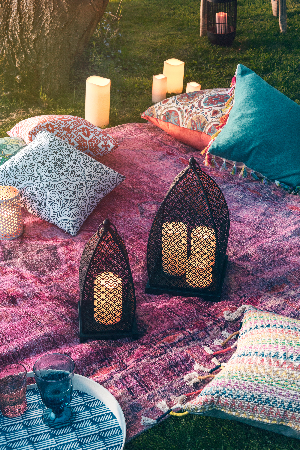
Styling Your Outdoor Spaces With Colourful Accessories
Friday, November 20, 2020
Elevate your outdoor space from a mere extension of the living room to a spot of magical potential with colourful add-ons.
Even when subjected to unpredictable weather conditions and wilful sprawls of greenery, the outdoors is just as viable a canvas for creative expression as the interior – and a home would be profoundly incomplete without an inviting yard or patio to extend living areas. If you have the outdoor space to spare, you may be thinking of providing an alternative to lounging indoors by setting aside a patch of grass or floor and adding furniture to it. Appointing your lawn with furnishings in white may be the strongest initial compulsion, but if you want to imbue your outdoor hangout with some semblance of colour, we have some ideas on how to make that happen.
Bright Nights
 Image Credit: Lights4Fun
Image Credit: Lights4Fun
A standard seating arrangement is a sufficiently practical consideration for providing a place to relax, but a certain measure of magic is necessary to make an outdoor space captivating. To dress a space as though it was transported from the realm of fantasy, consider pairing a boldly coloured rug with fairy lights strung over tree branches to mimic the stars of the night sky.
 Image Credit: Lights4Fun
Image Credit: Lights4Fun
Through both the mystical quality of floating illumination and the striking contrast of bold colours against a natural backdrop, the result is that even the most temporary of lounge spaces are elevated to enigmatic heights.
Bold Fun
 Image Credit: Carpetright
Image Credit: Carpetright
Other than surrealist landscapes born of imagination, few visual compositions are as striking as a product of human hands throwing boldly saturated colours against the verdant green of Mother Nature’s work. The contrast is perhaps as much thematic as it is about colour or shade – the same effect can be achieved with everything from a decorative sculpture to a practical arrangement of furniture.
 Image Credit: Carpetright
Image Credit: Carpetright
With a background of green grass, the stage is set for a stunning contrast to be made with brightly coloured furniture, decorations, or accessories to facilitate entertainment in your outdoor space.
 Image Credit: Carpetright
Image Credit: Carpetright
Tip: Put against the background of a lawn, nearly any manufactured object is instantly made worthy of attention – thanks to the subtle difference in natural or artificial colours and the obvious disparity in theme.
 Image Credit: Carpetright
Image Credit: Carpetright
Pastel Pretty
 Image Credit : Annie Sloan
Image Credit : Annie Sloan
There is an undeniably distinct relationship between pastel shades and rural settings, perhaps due to the prevalent sight of sun-bleached colours in provincial landscapes. Despite the fact that most people now live in urban areas, the association between pastel colours and the serenity of the countryside has moved from a feature of some people’s memories to a cultural trope that is recognisable even to those born and raised exclusively in cities. Selecting architectural finishes, furniture, or decorations in pastel shades, reinforces a rural theme in the yard and immediately transports anyone who rests there to a simpler time and place.
 Image Credit : Annie Sloan
Image Credit : Annie Sloan
Tip: A rural theme consists of more than just pastel shades – consider mimicking the weathering effects of the elements, then embellish the space with greenery and pale fabrics.
Natural Hues
 Image Credit: Annabel James
Image Credit: Annabel James
Bright splashes of colour do not necessarily need to come from products injected with dyes or coated in pigments – after all, Mother Nature is the single most prolific artist around. As can be observed in any place where foliage is given free reign, Nature tends to utilise all the visible colours of the light spectrum, and every definable shade in between, in the formation of flower petals.
 Image Credit: Annabel James
Image Credit: Annabel James
While entailing a greater degree of care and maintenance than a manufactured piece of furniture or decoration, there are few sources of colour as powerful or authentic as a bed of vibrant flowers.
 Image Credit: Annabel James
Image Credit: Annabel James
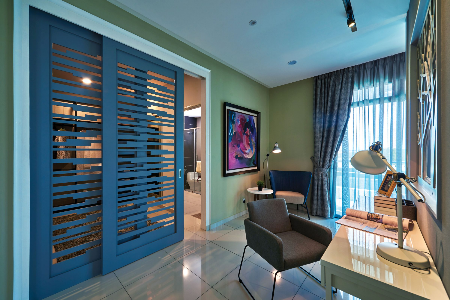
Impressive Studies: Inspirational Designs for Home Offices
Friday, November 20, 2020
Some of us bring our work home with us — but without a proper desk to work on, all those files and documents will seem out of place on the dining table. For those in need of some inspiration for a home office, we assembled some of the finest studies we have seen here for your perusal.
 A study doesn't necessarily require a significant investment in furniture but with some additional space afforded for a sliding partition, a quiet place of work can be guaranteed. Interior design by: Design Base
A study doesn't necessarily require a significant investment in furniture but with some additional space afforded for a sliding partition, a quiet place of work can be guaranteed. Interior design by: Design Base
 Doubling up on spaces is a valid approach to take when faced with a shortage of space. As pictured here, a viable solution is to combine the study with a generous walk-in wardrobe for intimacy. Interior design by: Jashen Interior
Doubling up on spaces is a valid approach to take when faced with a shortage of space. As pictured here, a viable solution is to combine the study with a generous walk-in wardrobe for intimacy. Interior design by: Jashen Interior
 The epitome of home offices, the kind all aspiring executives pine for, is pictured here. Encased in glass and saturated in white, this box simultaneously provides an overwatch position and solitude. Interior design by: Regal Violet
The epitome of home offices, the kind all aspiring executives pine for, is pictured here. Encased in glass and saturated in white, this box simultaneously provides an overwatch position and solitude. Interior design by: Regal Violet
 While being relegated to the corner of this bedroom, the wash of violet light marks out the larger area as belonging to the study. Interior design by: Design Base
While being relegated to the corner of this bedroom, the wash of violet light marks out the larger area as belonging to the study. Interior design by: Design Base
 Faced with a shortage of space in this bedroom, the study is instead made to project from the centre of the space, with a stand of shelves providing a form of containment for the bed. Interior design by: Design Base
Faced with a shortage of space in this bedroom, the study is instead made to project from the centre of the space, with a stand of shelves providing a form of containment for the bed. Interior design by: Design Base
 With an entire room to dedicate, this study is decorated with a certain degree of freedom that is uncommon for these normally compact spaces. Interior design by: A Piece of Art
With an entire room to dedicate, this study is decorated with a certain degree of freedom that is uncommon for these normally compact spaces. Interior design by: A Piece of Art
 This pictured study occupies a surprisingly small footprint on a staircase landing, turning a potentially unused space into a functioning workspace. Interior design by: Nu Infinity
This pictured study occupies a surprisingly small footprint on a staircase landing, turning a potentially unused space into a functioning workspace. Interior design by: Nu Infinity
 Just as with regular work, schoolwork tends to overflow into time spent at home, which necessitates a desk to work on. In this shared bedroom, the workspace is squeezed into a sunlit space beneath a bunk. Interior design by: GDY Design & Construction
Just as with regular work, schoolwork tends to overflow into time spent at home, which necessitates a desk to work on. In this shared bedroom, the workspace is squeezed into a sunlit space beneath a bunk. Interior design by: GDY Design & Construction
 This pictured study demonstrates the ultimate space-saving design for work surfaces, with a minimalist and monochromatic surface unfolded from a wall of cabinets. Interior design by: Sunpizz Kitchen & Home
This pictured study demonstrates the ultimate space-saving design for work surfaces, with a minimalist and monochromatic surface unfolded from a wall of cabinets. Interior design by: Sunpizz Kitchen & Home
 There's a certain comfort to be had in sleeping between partitions, and this study serves to provide a work surface as well as sheltering the bed in a safe berth. Interior design by: Sky Creation
There's a certain comfort to be had in sleeping between partitions, and this study serves to provide a work surface as well as sheltering the bed in a safe berth. Interior design by: Sky Creation
 Monochrome is used here to disguise the presence of a desk in and among the formation of bookshelves lining the wall. Interior design by: Nice-Style Refurbishment
Monochrome is used here to disguise the presence of a desk in and among the formation of bookshelves lining the wall. Interior design by: Nice-Style Refurbishment
 Another variation of shared spaces could see a secondary lounge turned into part of a study, as pictured here. Interior design by: Jashen Interior
Another variation of shared spaces could see a secondary lounge turned into part of a study, as pictured here. Interior design by: Jashen Interior
 Outside of individual rooms, there often is a hallway or a stairway landing that can provide sufficient space for a fully equipped study. Interior design by: Casa Indah Design
Outside of individual rooms, there often is a hallway or a stairway landing that can provide sufficient space for a fully equipped study. Interior design by: Casa Indah Design
 In compact bedrooms, the study surface often projects from the wall to be counted as an extension of bedside surfaces. Interior design by: Design Base
In compact bedrooms, the study surface often projects from the wall to be counted as an extension of bedside surfaces. Interior design by: Design Base
 In this child's bedroom, the study berth projects from the wall in monochromatic fashion to serve double duty as a decorative feature. Interior design by: Casa Indah Design
In this child's bedroom, the study berth projects from the wall in monochromatic fashion to serve double duty as a decorative feature. Interior design by: Casa Indah Design
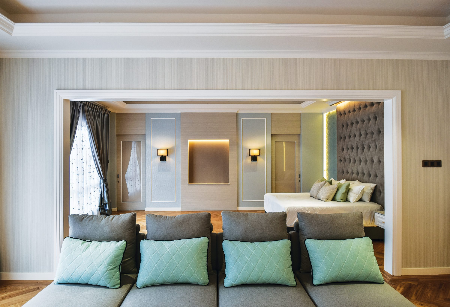
Home Styles: Modern Classic
Friday, November 20, 2020
Antithetical yet complementary: modern classic style is a delicate balance struck between timeless features of tradition and the uncomplicated lines of modern design.

Rare materials transported across great distances, and decorated with finely handcrafted details at incalculable cost – these were the standards of luxury during the immeasurable periods of time that preceded modern mass manufacturing. But as new republics arose from the ashes of old empires, the arrival of the steam engine brought a paradigm shift that led to a global redistribution of wealth and authority – and consequently changed what was considered attractive.
 Tip: Shelves and displays composed from the straight lines of modern design represent an appropriately unobtrusive backdrop for objects of classical antiquity – especially when lit from within hidden recesses. The resulting thematic and visual contrasts of these arrangements make for striking presentations on multiple levels.
Tip: Shelves and displays composed from the straight lines of modern design represent an appropriately unobtrusive backdrop for objects of classical antiquity – especially when lit from within hidden recesses. The resulting thematic and visual contrasts of these arrangements make for striking presentations on multiple levels.
On the rising wave of machine-aided manufacturing, designs for everything from clothing to transportation began to sway towards dependable simplicity and reproducibility, while shying away from the ornate and opulent. Modernism eventually gave rise to minimalism, which sought to strip everything down to its most practical and functional form, but some characteristics of classical luxury endured to the present day – romanticised and emulated either in desperation for emotional expression or admiration for classical antiquity.
This is the very definition of the modern classic decorative style – a union of traditional and modern sensibilities expressed in the choice of furniture and materials to achieve a décor that is simultaneously elegant, timeless, and comforting. Hue Interiors illustrates the definition of modern classic style with the pictured home, which combines modern characteristics – such as a reliance on straight lines and a neutral colour palette consisting largely of grey, white, cream, and beige – with traditional details such as the capitonné upholstered headboard for the bed, wainscoting to vertical surfaces, Damask wall-coverings, and a herringbone pattern in wood on the floor.

While the classically inspired components of the pictured décor are intentionally obvious, the modern sensibilities expressed here are less so. Aside from the neutral palette, other more subtle characteristics of modern style are expressed in the manner of composition – namely: the application of symmetry, visual balance, and a stringent emphasis on using clean lines to serve as a backdrop for the array of classical details.

As Hue Interior demonstrates, the composition of the bedroom in symmetry, the use of neutral shades, in addition to both classical and modern elements presented in harmonious balance help to render the bedroom comforting and unobtrusive – making an ideal backdrop for intricate details drawn from traditional influence. The reliance on straight lines, as portrayed by the bedroom’s fixtures and fittings, provides the very minimum of distinction between objects without detracting from the visual splendour of the classical details.
 Tip: Perhaps due to the paradoxical differences between modernity and classicism, the blending of characteristics from these two decorative styles creates an atmosphere that is at once mystifying and comforting.
Tip: Perhaps due to the paradoxical differences between modernity and classicism, the blending of characteristics from these two decorative styles creates an atmosphere that is at once mystifying and comforting.
In addition to the lush textures and fine details occupying the walls – which already imply a more prosperous and upwardly mobile ambiance on their own – the positioning of ornate furniture, paintings, or sculptures, under the flattering glow of a feature light create additional elements of luxurious elegance against a clean and uncluttered background of straight lines and neutral shades.
 Tip: As demonstrated in the pictured home, there is no ideal proportion of modernity to classicism set in stone – as the decorative palette can be inverted for contrast between spaces.
Tip: As demonstrated in the pictured home, there is no ideal proportion of modernity to classicism set in stone – as the decorative palette can be inverted for contrast between spaces.

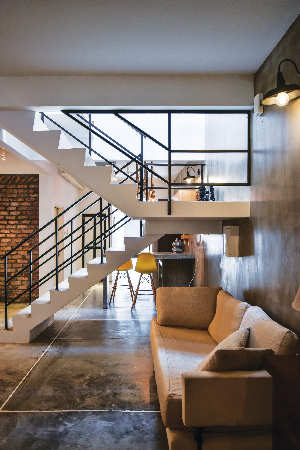
Home Styles: Warm Industrial
Friday, November 20, 2020
In contrast to the potentially cold character of industrial décor, there is a friendlier variation with warming shades and a range of textures layered over finishes of urban appeal.
With sturdy materials in utilitarian designs reminiscent of minimalism, industrial style has been found appealing by urbanites even before the turn of the millennium – but new families living in converted lofts and townhouses often sought a softer ambience not quite so replete with edgy contours and unfinished textures. As the earliest industrial properties evolved, a more nuanced and family friendly variation of industrial style emerged: with contemporary sensibilities portrayed in a blend of neutral colours, a reliance on wooden decorative features, and a purposeful sprinkling of rustic embellishments to turn cold, urban spaces to warm and rural sanctuaries.

While a neutral palette is likely the single most ubiquitous feature of most modern homes, a warm industrial décor entails raw or lightly treated architectural finishes such as hand-trowelled cement floors and exposed brickwork in place of glossy expanses and bold colours. As demonstrated by ID Industries in the pictured home, reflective surfaces and bold shades are not completely avoided, but are instead relegated to serve as accents alongside repurposed antiques and upcycled materials.
As the finishes consist largely of materials such as exposed cement, roughly hewn bricks, and carbonised metal, the resulting décor appears aged and definitively industrial. The majority of colours and textures observed in the pictured home are supplied by vintage finds and sturdy materials seemingly appropriated from industrial settings – contributing to an assembly of textures saturated in the faded shades of the neutral palette.
While the majority of this home relies on a palette of tones softened by age, the furnishings of the pictured seating lounge are upholstered in bright yellow to serve as eye-catching accents against the weathered finishes. The striking contrast of whimsical colour thrown against a sombre background is a novel sensation to most people – though likely a familiar sight to loft-dwelling artisans – and all but guarantees a surge of interest when the gaze first falls to this scene.

Bolstering the décor of a warm industrial home are structures typically formed out of aged materials such as darkly stained or weathered wood. The pictured television console is constructed from blocks of wood that could have once served as railway sleepers, while the dining arrangement consists of side chairs that put their implied antiquity in direct contrast against a table of modern design.

In adherence to the larger considerations of industrial style, the open layout is extended to the far end of the home to include the cooking space. Ordinarily set apart from the rest of the home as a practical consideration in modern homes, this pictured kitchen is brought into the fold with the rest of the décor by way of hand-trowelled cement rendering the floor, walls, and an island surface projecting from the wall.

In a deliberate echoing of the colour contrast observed in the seating lounge, a pair of Eames-inspired bar stools in bright yellow are selected to accompany the kitchen island.


Tip: As a general guideline, warm industrial style is composed from largely raw materials of minimalist designs – as is the case with postmodern industrial style – albeit with generous doses of dark wood and a few bursts of whimsical colour.
Comprehensive Practitioners
A renovation, refurbishment, and contracting company that provides the complete range of services involved in the total transformation of a property. Their services include design conception, architectural planning, documentation, quantity assessments, quotations, through to project implementation and completion.
 From left to right: Cindy Hu, Peggy Yap, Andy Lai, Jessie Tai, and Chew Kok Ming
Venue: GoldenHome Kitchen @ Glenmarie
Kitchen Appliances: Teka Küchentechnik Malaysia
Photographer: Gavin Yam
From left to right: Cindy Hu, Peggy Yap, Andy Lai, Jessie Tai, and Chew Kok Ming
Venue: GoldenHome Kitchen @ Glenmarie
Kitchen Appliances: Teka Küchentechnik Malaysia
Photographer: Gavin Yam
ID Industries Sdn. Bhd. A-G-06 & A-3A-06 Block Allamanda 10 Boulevard Lebuhraya Sprint, PJU 6A 47000 Petaling Jaya Selangor Darul Ehsan, Malaysia
Other Outlets +603 6157 3933
+603 6157 3933
 +603 6156 7833
+603 6156 7833
 www.id-ind.com
www.id-ind.com
 @idindustries
@idindustries
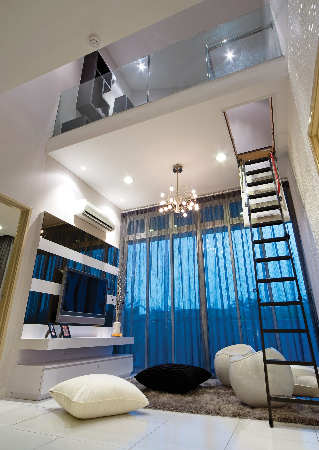
Choosing the Right Decorative Style for You
Friday, November 20, 2020
We've looked at kitchen countertop materials to describe various materials and how they may be suited to different personalities – but until now, we have not attempted to apply that same perspective to decorative styles. While decorative styles are probably as varied as people, we have been seeing some similar personalities gravitating towards particular aesthetic styles – which we will attempt to describe here for the benefit of anyone who might be in the midst of finding themselves and their preferred decorative style.
There are innumerable methods for analysing personality, but perhaps the most stringently tested theoretical framework would be that of the Big Five personality traits (openness, conscientiousness, extraversion, agreeableness, and neuroticism) – which will be the theory we adopt here in order to generally associate a particular decorative style with a dominant personality trait.
Openness
One of the first Big Five personality traits to be discussed is usually an individual's "openness to experience" – which roughly translates to a person's imagination and bravery to venture into uncharted waters. A person who is considered high in "openness" is regarded as being receptive to variety – easily gravitating towards learning, art, or other creative pursuits; while a person low in "openness" will display a preference for routine and representational works of art such as classical sculptures rather than abstract or interpretive designs.
 It takes a certain kind of bravery to seek out and incorporate unconventional features — such as the pictured loft space, made accessible with the addition of an industrial attic (loft) ladder. Interior design by: Nice-Style Refurbishment
It takes a certain kind of bravery to seek out and incorporate unconventional features — such as the pictured loft space, made accessible with the addition of an industrial attic (loft) ladder. Interior design by: Nice-Style Refurbishment
Historically accurate decorative styles such as faithful classicism may not be ideal for highly open individuals, who tend to prefer more varied, esoteric, or eccentric blends of styles to reflect their unique tastes. An open person would seek to forge a unique décor wherever possible – perhaps even going as far as rearranging entire floor plans to achieve something different. On the flipside, a less open person may gravitate toward styles that are more commonly represented in today's homes – or even a style representing something from childhood – while adhering to the convention of the day as much as possible.
Conscientiousness
Describing how people react to expectations of society at large, a person high in conscientiousness is more likely to consider rules both written and unspoken – such as is required when attempting to pay tribute to classical aesthetics. A highly conscientious person considers the experience of guests and visitors more than their own comfort, and will likely seek out a familiar décor – such as a variation of modern contemporary or classical modern style – to achieve a comforting ambience for the benefit of others while aiming for the hallmarks of luxury.
 A conscientious homeowner seeks to enforce implicit aesthetic rules rather than break them. Designer: Design Integra
A conscientious homeowner seeks to enforce implicit aesthetic rules rather than break them. Designer: Design Integra
A less conscientious individual may be seen as unpredictable and impulsive – and the right decorative style in this case is more a matter of personal preference than anything else. A person low in conscientiousness will likely gravitate towards a unique décor to represent their singular personalities, rather than adhering to convention for the satisfaction of guests.
Extraversion
The dichotomy of extraversion and introversion is perhaps the most popular of facets in personality research – a person is considered extroverted when they display an innate attraction for social activity, while an introvert is one who values alone-time over a stint of hanging out.
 The home of an extravert will more than likely present bold shades favoured by exuberant personalities. Interior design by: Surface R
The home of an extravert will more than likely present bold shades favoured by exuberant personalities. Interior design by: Surface R
Extroverts plan their home around social events, considering factors like the placement of extra seating and opting for bold colours rather than relying on a neutral palette. Introverts, on the other hand, will prefer to design for personal comfort and use softer colours in the creation of solitary spaces such as the study or the bedroom.
Agreeableness
A person is considered agreeable when they display a high sensitivity for the feelings of others – and their decorative choices might closer reflect the norms of modern styling, while less agreeable individuals may be seen as being more concerned with their own avenues of self-expression.
 Individuals high in agreeableness will tend to prioritise the familiarity of the neutral palette and twentieth-century designs over self-expression. Interior design by: Alpex Design
Individuals high in agreeableness will tend to prioritise the familiarity of the neutral palette and twentieth-century designs over self-expression. Interior design by: Alpex Design
The most intriguing and awe-inspiring decorative styles are to be found in the homes of less agreeable individuals – while one can expect something more contemporary, less esoteric, and with greater mass-appeal in the home of an agreeable person.
Neuroticism
As a measure of emotional stability and how well a person copes with stress, the trait of neuroticism is not as well associated with any particular decorative style as any of the four previously described personality traits – but some conclusions can still be drawn. For instance, a highly neurotic person with a stressful career may have no use or appreciation for a study — the mere sight of a workstation may elicit feelings of frustration in the home.
 A carefree personality, low in neuroticism, lets stress roll right off and wouldn't be the least bit disturbed by clutter or asymmetry. Interior design by: Pins Studio
A carefree personality, low in neuroticism, lets stress roll right off and wouldn't be the least bit disturbed by clutter or asymmetry. Interior design by: Pins Studio
Neuroticism also informs how one deals with clutter in the home, a person who is more inclined to keep spaces clean, and is also less willing to cope with the stress of a mess, will likely be on the lookout for storage options – while the messier and less neurotic among us may not have even considered cleaning up at all.
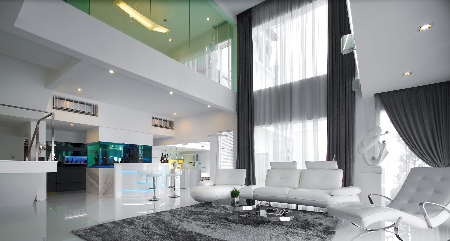
Cavernous Spaces: Living Rooms With Double Height Ceilings
Friday, November 20, 2020
Few parts of the conventional modern home feature high ceilings in the default plans, but the existence of a double-height ceiling in your living room is a rare opportunity to decorate boldly along the vertical axis with extra-long curtains and feature walls. If you're fortunate to have in your possession a canvas as generous as a living room with an extra high ceiling, here are some examples of what can be achieved in these spaces.
Immaculate Simplicity
 Interior design by: Regal Violet
Interior design by: Regal Violet
A dependance on the lighter side of the neutral palette expands the perceived space, as demonstrated by Regal Violet in this seating area. Utilising only grey fabrics to complement a background of white furnishings and finishes, the designers of the pictured seating lounge have managed to retain the voluminous quality of this space – with the grey elements drawing attention to the generous length of windows and to the centre of the seating arrangement.
 Interior design by: Regal Violet
Interior design by: Regal Violet
The prevalence of white and grey prepares the naïve eye for the glorious bursts of yellow light that become apparent from the centre of the lounge.
Monochromatic Modernity
Rendered with glossy black curves across the white finishes, this seating lounge is designed by Deseo Creativo to speak of the modern notion of elegance in simplicity. The monochromatic background of this home sets the eye up for the scant streaks of blue, while the simplistic palette creates a striking contrast against the ornate chandelier and the seamless expanse of marbled stone on the floor.
 Interior design by: Deseo Creativo
Interior design by: Deseo Creativo
Tropical Luxury
 Interior design by: DMZ Consultancy
Interior design by: DMZ Consultancy
The designers of the pictured seating lounge, DMZ Consultancy, craft a space suited for the tropics by relying on the lighter side of the neutral palette and an assortment of natural materials. The neutral palette saturates this living room in seamless stretches of stone on the floor and walls while wood decks the ceiling. Coupled with the exquisite view and splashes of greenery on the interior, the result is simultaneously luxurious and uplifting.
 Interior design by: DMZ Consultancy
Interior design by: DMZ Consultancy
Sunny Vibes
 Interior design by: Homlux Interior Furnishing
Interior design by: Homlux Interior Furnishing
In spaces gifted with generous windows such as this seating lounge with an extra-height ceiling, the choice of interior colour could be heavily swayed by the quality of view. Given that the wooden patio on the outside lies in full sunlight during the day, the practical use of louvres on the windows removes the need for extra-long curtains and enables the ingress of sunlight to complement the yellowish décor of interior.
 Interior design by: Homlux Interior Furnishing
Interior design by: Homlux Interior Furnishing
If you've settled on your approach to decorating the living room, here are some of our thoughts on lighting up the whole ensemble.
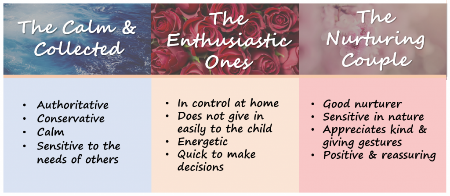
The Parenting Personality Palette
Friday, November 20, 2020
Nippon Paint Malaysia uncovers some of the key parenting personality traits based on your most frequented colour!
Did you know that your favourite colour reveals your dominant parenting style? Certain studies on the psychology of colour that have been carried out indicate that your preferred colour closely reflects some of your most dominant personality traits and strongest characteristics; even down to the various ways in which you behave towards your child (or children!). Take for instance, parents who prefer the blue hues are often regarded as more dependable and calm figures whilst those who gravitate towards brighter shades are known to be more assertive parents with a stronger personality. If you have more than ONE favourite colour, you may not have all the traits from one particular colour, but instead your parenting style comprises of a mixture of the various characteristics. Let’s say if you’re fond of hues such as pink and yellow, you may have a sensitive personality with enthusiastic vibes.


Read on below to find out if your favourite shade closely reflects your parenting traits.
The Parenting Personality Palette
It’s time to reflect upon your true colours and see if your favourite colour resonates closely with your respective parenting traits.
Nippon Paint Malaysia offers a wide range of colours that matches your parenting personality to the tee, ranging from dark to the lighter spectrum of hues, from warmer to cooler colour shades. There’s mocha brown, khaki green, rose-pink… and the list goes on!
How about taking inspiration to the next level and reflecting your parenting personality colour(s) on the walls of your home?
Here are some colours from Nippon Paint to consider for your next redecorating project at home featuring your parenting personality colour complemented with other suitable shades:
The Calm & Collected (Blue)
The colour blue is recognised as the most calming shade of the colour spectrum, which makes it one of the top choices of favourite colours around the world. If you find yourself not overreacting to your children most of the time, the colour blue reflects your calm persona best.

To create overall soothing vibes all around your home, select colours such as light green, or a light peach to fully complement your blue themed walls. If you’re a true-blue fan, you could even opt for pairing the palest blue with navy without overwhelming your entire room.
The Enthusiastic Ones (Red)
Red is known to be a strong colour that resonates well amongst those that carry a more dominating trait. Parents who favour the colour red are typically strong-willed – and much like the colour, they do not easily give in to a child’s requests.

However, in a home, everything in the colour red may be too overwhelming… so why not try balance red with softer shades such as light grey or neutral beige tones for a greater contrast?
The Nurturing Couple (Pink)
Those who like the colour pink often convey a reassuring ear to their children and see things in a positive light in most situations. While light pink is gentler on the eyes; some are a fan of brighter pinks such as fuchsia which also look great on walls if paired with clean colours such as beige or the lightest shade of yellow.

If you’re a fan of lighter shades of pink, try complementing this with light pink tones for a classy look or opt for striking blue for fun vibes.
The Fair Minded (Green)
A colour that reflects the personality of a calm yet logical and analytical figure who often takes a more supportive and nurturing approach at most instances. If you find yourself reasoning with your child or children over their actions, green is the colour for you. Being a neutral shade, green can be paired with almost any shade on the colour wheel, depending on the desired ambience for your room.

To fully resonate with your calm personality, go along the lines of a pastel pink with a soft peach shade. Otherwise, for those who prefer strong green undertones, match your green feature wall with a light oak brown shade for a down-to-earth vibe.
The Cool Ones (Yellow)
Yellow represents the colour of enthusiastic parents who are often easily excitable over most things, their children included. When you think yellow, the first word that comes to mind is ‘bright’! …which makes the colour an easy feat to match with two extremes, either choosing to pair it with a pale colour or opting for colours on the darker end of the spectrum.

For a dark colour, shades such green or grey makes for a good contrast against any yellow-themed feature wall. For an earthier tone, opt for colours such as brown.
Here are some top tips to consider when repainting your home!
- To ensure a safe environment for your child/children, try a child-safe odorless paint from Nippon Paint’s Child Wellness Range (For more information, log on to: www.nipponpaint.com.my/childwellness)
- Opt for colours which are contrasting to your feature wall for a vibrant look
- Measure the space of each room to get an estimated amount of paint required
- Care for the walls of your home by ensuring proper preparation is carried out (i.e priming the walls prior to painting)
- Have a rough idea on your overall colour theme. Fret not if you’re unsure of what colour suits your room best and opt for expert advice from Nippon Paint’s Colour Scheme Professional Services at www.colourscheme.com.my to get the perfect recommended shades for your rooms.
If you’re looking to repaint the walls of your home but are unsure where to begin, visit www.nipponpaint.com.my to spark some inspiration!
Text and images by Nippon Paint




